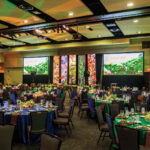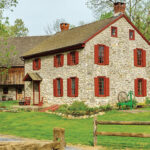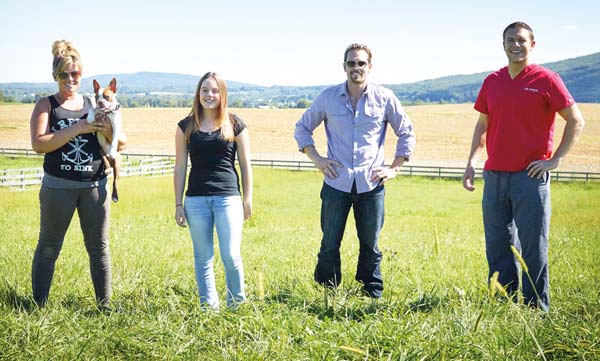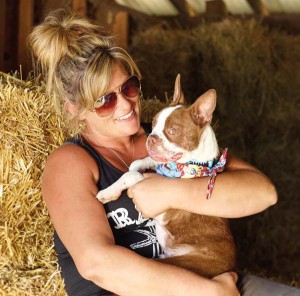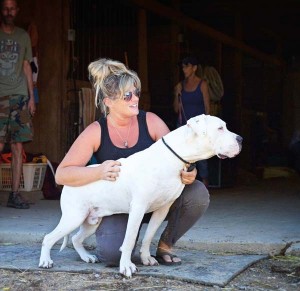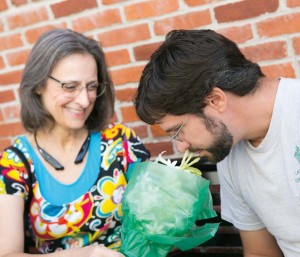In 2008, reporter Lisa Ling exposed puppy mills to viewers of the Oprah Winfrey Show. “It is my belief that when you actually see this, America, with your own eyes … that you are not going to stand for it,” Oprah told her audience. Things did change. For a while. Now, a puppy named Libre has taken Oprah’s challenge a step further. Thanks to social media, the world is now outraged. Meet the four people who played key roles in taking Libre from a worst case scenario to the best life ever.
Dextin Orme
Dextin, who grew up in northern Lancaster County and is a graduate of Cocalico High School, is a committed dog lover who has supported and volunteered with several animal welfare organizations over the years. He shares his Lancaster City home with his beloved 9-year-old pitbull/terrier mix, Bud.
Dextin’s job as a produce driver (he’s also a server at El Serrano in Lancaster) takes him around the county, picking up organically grown produce from farms and delivering it to clients in the Philadelphia area. Along the way, he has made the acquaintance of many farm dogs. “I like to keep a check on them,” he says.
In May, Dextin took note of a puppy on a farm in southern Lancaster County. While his litter mates had all been adopted, this one had been returned. “He appeared to have a skin condition,” Dextin says. On subsequent visits, Dextin noted that the puppy’s condition was deteriorating. Dextin was told by the “breeder” that the puppy was being treated by a veterinarian but was not responding. That was not the case.
By early July, Dextin was alarmed – and angered – by what he saw. According to Dextin, “The puppy appeared to be dead.” To his relief, the puppy’s eyes opened when he heard the sound of Dextin’s voice.
He shared his concerns with the county’s humane officer, Susan Martin. Not satisfied with the response he was receiving, Dextin took matters into his own hands and asked the breeder/farmer if he could have the puppy so that he could seek treatment for him. He agreed to Dextin’s request and on the way back to the city on the morning of July 4, Dextin called a former humane officer, Jennifer Nields, for advice and help.
It turned out that the puppy had more than a “skin condition.” The diagnosis was demodectic mange. According to peteducation.com, mange occurs when mites are transferred from the mother dog to her puppies. In most cases, the puppies are not affected by the mites. However, if they have inadequate or poorly developed immune systems, the mites can do damage. (Subsequently, older dogs with compromised immune systems are also susceptible to mites.) Oftentimes, hair loss and lesions first appear on a pup’s face due to close contact through nursing. This typically occurs at around 4 months of age, which was this puppy’s age at the time he was removed from the farm.
Dogs that have given birth to puppies that fall prey to mange should not be bred again. The fact that mites are being passed from mother to pup is not crux of the problem, rather it’s a genetic indicator that the mother is passing on an inferior immune system. This puppy’s mother (who was turned over to the Lancaster County SPCA and has since been adopted) also reportedly displayed a mild case of mange.
Jennifer Nields
Jennifer is an unabashed animal lover. She’s also a former humane officer. “I’ve seen some bad situations,” she says. She names Libre’s condition as being “close to the worst I’ve seen. I’d definitely put it in the top five.” A graduate of Conestoga Valley High School, Jennifer spent her senior year at the Willow Street campus of the Lancaster County Career and Technology Center, where she was enrolled in the Veterinary Assistant program. “I’ve loved animals ever since I was a kid and knew I wanted to do something in that field,” she says. In 2013, she joined the staff of the Lancaster County SPCA. She started as a kennel tech, working her way to becoming the operations manager and education coordinator. Eventually, she became a humane officer.
While puppy mills receive the lion’s share of attention, Jennifer is of the opinion that backyard breeders and hoarders equally contribute to the cruelty, abuse, over-population and homelessness that plague not only this country, but also the world. Add in dog fighting and cultural and regional outlooks that dispel the need for spaying and neutering animals, and you have the recipe for an epidemic that before the dawn of social media was a cause that only the most dedicated dog and cat people battled. Blame also falls on owners who simply lose interest in their pets (or find them to be too much of a responsibility) and banish them to the backyard, where they are ignored. Now, thanks to the Internet, Facebook and other social media, animal welfare stories are literally in our faces on a daily basis.
Despite heightened awareness, Jennifer says it would surprise people to know what humane officers see in a day’s time. Puppy mill operators, hoarders, backyard breeders and dog-fighting operations become very adept at hiding their secrets. “They have dogs and cats stashed in closets, bathrooms, basements, barns and trailers,” she says. “They try to distract you and take you in the opposite direction of where the animals are hidden.” The job can take a toll on your psyche. “All you want to do is take them all home,” she admits. Indeed, she has taken a few home, including two pitbulls, two cats and two birds – a small-scale Noah’s Ark of sorts.
Today Jennifer is employed by the Adamstown Veterinary Hospital. “I had never worked in a hospital setting before, so I’m learning all sorts of new things,” she says. As her comfort level grows, she is expanding her horizons and doing a variety of things for the practice. However, in her heart she knows that someday she will once again be a humane officer.
The puppy Dextin handed over convinces her of that. Jennifer took the puppy to Lancaster’s Pet Emergency Treatment and Specialties. “He didn’t even look like a dog,” she recalls. “And, the smell. It’s indescribable.” Still, during the ride to PETS, she tried to comfort the pup, who was wrapped in a blanket. The vets at PETS said death was imminent, but Jennifer said to hold the phone. She instinctively knew who to call: Janine Guido of Speranza Animal Rescue in Mechanicsburg. “Everytime I talked to the dog, he opened his eyes,” Jennifer explains. “I told Janine that indicated to me he had a chance.”
Janine Guido
Janine grew up on a farm in Mechanicsburg, riding and training horses. “Then, my knees gave out,” she says. Dogs had always been a part of her life, and soon she became involved in rescuing them. Four years ago, she founded Speranza Animal Rescue on the family farm. “Speranza,” she explains, is the Italian word for hope. “What do you expect from someone named Guido!” she jokes. Speranza became a haven for dogs that are challenged, whether it’s from a behavioral, medical or social standpoint. She says she has a special place in her heart for handicapped and special-needs dogs and vows, “We will not turn any dogs away.” Speranza is also unique in that it provides long-term care for its residents, whether they’re dogs, cats, pigs or horses. Janine is also a champion for pitbulls. She’s a dog whisperer of sorts and has been known to sit in rain, snow or through the dead of night to convince a stray dog to trust her.
When Janine received Jennifer’s call, she immediately headed for Lancaster. Before she even laid eyes on the dog, Janine felt an unexplained connection to him. “I walked into that place a basket case,” she remembers. “I think my emotional response had to do with the fact that he was a helpless puppy.” She was horrified by what she saw (and smelled). Like Jennifer, Janine instinctively swung into action and placed a call to Dr. Ivan Pryor at Dillsburg Veterinary Center. If anyone could bring this pup back from the brink of death, it was him.
Janine named the dog “Libre,” which is the Italian word for freedom. In view of the fact that he was rescued on the Fourth of July, she thought it was an appropriate name.
Dr Ivan Pryor
Something told Ivan and Sharon Pryor to turn down picnic and party invitations for the long July Fourth weekend. “All we wanted to do was stay home and relax,” Sharon (pictured above) says, explaining that the practice had been unusually busy during the spring and early summer. The phone rang on the evening of the 4th. It was Janine. She had a patient for them. The next morning, following Libre’s discharge from Lancaster PETS, Janine and Libre met the Pryors at their office. It was bad. Very bad. Libre’s mange had morphed into a secondary infection, causing his hairless skin to fester and ooze. Malnutrition and dehydration had compromised his organs. He was emaciated. He had no muscle tone. His white blood cell count was very high. His eyes were ulcerated. Survival was on an hour-to-hour basis.
Dillsburg’s staff swung into action, treating Libre’s skin with medication, special baths and laser treatments. Specialists examined his eyes. Despite the dire situation, Libre fought against all odds and accepted small offerings of food and water. Janine promised him the world if he survived. The Pryors packed him and his medical supplies up every night and took him home with them for the next month. “He required 24-hour care for weeks,” Sharon explains. “The month of July was one of the most physically and mentally draining months at our practice, but it was definitely the most rewarding. We look at it as a complete blessing. It was a privilege to be a part of Libre’s recovery.”
Meanwhile, social media was blowing up with Libre’s story. Dillsburg Veterinary Center was deluged with emails and telephone calls from well-wishers, as well as visits from the media. Newspaper stories and television reports were picked up by national affiliates, which helped to take the story coast-to-coast. “It was crazy,” Sharon remarks. Visits from the postal service, UPS and FedEx also increased. Well-wishers were sending clothing, toys, blankets, tributes (poetry to paintings) and money to Libre at the center’s address. “We were inundated,” Sharon says. Even Dr. Pryor’s favorite football team, the Kansas City Chiefs, sent gear and jerseys for him and Libre. “The likes for our Facebook page went from 3,000 to more than 85,000 almost overnight,” Sharon adds, noting that those “likes” represented people from all over the world. “People appreciated that we kept them up to date on Libre’s progress.”
The practice shared the good, the bad and the ugly. Some days the news about Libre’s condition was beyond depressing. Janine was a daily visitor, and Libre seemed to rally when he heard her voice. Then, on the evening of Saturday, July 16, a miracle occurred. A video of Libre gingerly walking around the Pryors’ kitchen was posted. Again, social media blew up. From that point, Libre progressed at an incredible rate. Janine called him her “bug-eyed miracle dog.”
Dr. Pryor, who was recently honored as the state’s “Veterinarian of the Year” by the Pennsylvania Veterinary Medical Association, says that Libre’s prognosis for full recovery is looking brighter with each passing day. “All his blood work has been good and even his eyes are improving,” he reports. His hair has grown back, and he’s become a bundle of energy.
The Beat Goes On
Janine and Libre had formed a strong bond over the course of his treatment. So, it only made sense that she would provide him with a forever home. Remember Libre’s response to voices? It seems that’s a classic trait of Boston Terriers: According to the American Kennel Club, Bostons are “very sensitive to the tone of voices,” which may explain his special connection to Dextin, Jennifer, Janine and the Pryors.
Developed by breeders in the Boston area during the mid-1800s, the Boston Terrier is a cross between the English Bulldog and the White English Terrier. The breed was officially recognized by the AKC in 1893. The Boston Terrier is immediately recognized because of its “tuxedo” coat, which according to AKC standards must be white/black, white/brindle or white/seal. Described as “friendly, bright and amusing,” the Boston Terrier is regarded as the “American gentleman” of the dog world. In the AKC’s estimation, their large, round and dark eyes give Bostons “a kind and intelligent expression that can melt the coldest heart.” They are regarded as great family dogs, and because they are easily trained and highly intelligent, Bostons are being seen in many television commercials.
Libre has essentially become a rock star. He is helping to raise awareness of puppy mills — in mid-September, he co-starred with Animal Planet’s Victoria Stilwell at an event in Maryland. He is also helping Janine raise funding for an expansion project at Speranza. “The response has been amazing,” Janine says of the various fundraising events that have been held, including a gala sponsored by Dillsburg Veterinary Center in late August. “We’re going to need a bigger venue next year,” says Dr. Pryor.
A call for blankets at the rescue resulted in a filled parking lot at Speranza on September 11. “The cars just kept coming,” Janine marveled on Speranza’s Facebook page. Earlier this year, the auto dealership, Bobby Rahall, presented Speranza with a check for $10,000. The Harrisburg National Horse Show made a $3,000 donation. A fundraiser held at the Black Horse Tavern in Denver in mid-September netted $1,500.
According to Sharon, fundraising prior to Libre’s arrival allowed Speranza to meet the code requirements of Monroe Township in Cumberland County. Going forward, fundraising will help with the daily needs of the rescue, as well as the expansion project, which in the end will enable Janine and Speranza’s dedicated volunteers to aid more dogs.

Oreo, who now resides at Speranza, came out of a hoarding situation. A malformed jaw causes his tongue to constantly be visible.
Libre has also become the face of change on the legislative front. Sen. Richard Alloway (R-33rd District) has introduced legislation – SB1372 or Libre’s Law – that will provide the state with stricter animal-cruelty penalties. As of early October, the bill had 17 co-sponsors. Similar bills have been introduced on the House side, including HB953, which is being sponsored by Rep. Keith Greiner (R-43rd District) and has 23 co-sponsors. Presently, Pennsylvania is one of three states in which animal cruelty is a summary offense that simply entails a fine. The laws in the other 47 states consider neglect and abuse a felony.
Libre’s case follows in the footsteps of Susie, a puppy that was nearly burned to death and was then abandoned in a park in Greensboro, North Carolina. She languished in the park for two weeks before being discovered by a passerby (who ultimately adopted the dog). Public outrage prompted a change in North Carolina’s laws in 2010. Susie is now a therapy dog whose attire often includes a tiara and pearls. The man who tortured Susie was given a jail sentence. Libre’s previous owner on the other hand was assessed a fine of $900, whereas the dog’s medical expenses are approaching $30,000 (fortunately, donations have covered most of them).
Senator Alloway also has two other dog-related bills in the pipeline. One is SB373, which prohibits dogs from being kept outdoors 24/7 or in extreme weather conditions. It passed in the Senate 45-4 in 2015 and has been in a House committee for the past year. SB78 would deny kennel licenses to immediate family members of operators who have had their licenses revoked. It passed unanimously in the Senate and is now making its way through the House.
Things have changed in Lancaster, as well. District Attorney Craig Stedman announced in August that local police departments will now assume the responsibility of conducting animal-cruelty investigations. The DA’s office has also become the point of contact for citizens concerned about possible animal cruelty taking place. They can now email the DA’s office with their concerns.


